Long-Term In Situ Performance Evaluation of Epoxy Asphalt Concrete for Long-Span Steel Bridge Deck Pavement
Abstract
1. Introduction
2. Study Area
2.1. Location and Design Parameters
2.2. Climate
2.3. Traffic Volume
3. Performance Evaluation of XHMB Pavement
3.1. Rutting Depth Index (RDI)
3.2. Riding Quality Index (RQI)
3.3. Pavement Surface Condition Index (PCI)
4. XHMB Pavement Condition Evaluation Based on Typical Distresses
4.1. Typical Distresses of XHMB Pavement
4.2. Pavement Performance Index (PPI)
4.2.1. Crack Index (CI)
4.2.2. Patching Index (PI)
4.2.3. Surface Deterioration Index (SDI)
4.3. XHMB Pavement Performance Evaluation Based on PPI
4.4. Performance Partition of XHMB Pavement
4.5. Performance Evolution of XHMB Pavement
5. Conclusions
- (1)
- After being opened to traffic for more than 10 years, the average RDs of XHMB pavement range from 1.67 to 2.57 mm, and the average RDIs of all four lanes are all higher than 95, which indicates the outstanding rutting resistance of the XHMB pavement.
- (2)
- Similar to the rutting condition, the roughness of XHMB pavement is in good condition. In 2020, the average IRIs range from 1.04 to 1.37 m/km and the average RQIs of the four lanes concentrate around 95.
- (3)
- The PCIs of the pass lanes and drive lanes in 2021 are greater than 94 and 86, respectively, which may imply favorable surface conditions and structural integrity of XHMB pavement. However, numerous distresses, including cracks, patching, and map cracking, widely distribute on the XHMB pavement with a close interval, which is far from the good surface condition reflected by the PCI. Hence, the PCI can hardly characterize the authentic surface conditions of OSBD pavement with a high resolution.
- (4)
- The cracks occupy the primary part of the XHMB distresses, followed by patching and map cracking. Therefore, a pavement performance index (PPI) consisting of the crack index, patching index, and surface deterioration index, was developed.
- (5)
- According to the PPI results, the XHMB pavement conditions are revealed with a high resolution compared with the PCI. The performance of the pass lane is superior to the drive lane. To be specific, the PPIs of the down direction pass lane are 100 mostly. By contrast, for the down direction drive lane, the PPIs for about 30% of the segments are below 80 or even below 60.
- (6)
- Based on the divergent XHMB pavement conditions, the performance condition of XHMB pavement in 2021 was divided into four different grades, with varying maintenance treatments required to rehabilitate the pavement performance.
- (7)
- According to the distress quantity of XHMB and the adjacent JTB, the distress of American ChemCo epoxy asphalt concrete may initiate after the concrete has served for 4–5 years. After the concrete was opened to traffic for about 10 years, the distress shows an outbreak trend. At this point, necessary structural maintenance is needed to rehabilitate pavement performance.
Author Contributions
Funding
Institutional Review Board Statement
Informed Consent Statement
Data Availability Statement
Conflicts of Interest
References
- Salamak, M.; Fross, K. Bridges in urban planning and architectural culture. Procedia Eng. 2016, 161, 207–212. [Google Scholar] [CrossRef]
- Corticelli, R.; Pazzini, M.; Mazzoli, C.; Lantieri, C.; Ferrante, A.; Vignali, V. Urban Regeneration and Soft Mobility: The Case Study of the Rimini Canal Port in Italy. Sustainability 2022, 14, 14529. [Google Scholar] [CrossRef]
- Zhao, Y.; Ni, F.; Zhou, L.; Jiang, J. Performance evaluation of long-span suspension bridge pavement based on long-term maintenance data. J. Mater. Civ. Eng. 2020, 32, 04019363. [Google Scholar] [CrossRef]
- Jia, X.; Huang, B.; Chen, S.; Shi, D. Comparative investigation into field performance of steel bridge deck asphalt overlay systems. KSCE J. Civ. Eng. 2016, 20, 2755–2764. [Google Scholar] [CrossRef]
- Liu, X.; Medani, T.; Scarpas, A.; Huurman, M.; Molenaar, A. Experimental and numerical characterization of a membrane material for orthotropic steel deck bridges: Part 2. Finite Elem. Anal. Des. 2008, 44, 580–594. [Google Scholar] [CrossRef]
- Zhang, X. Emergency and Long-term Measures of Steel Deck Pavement Distresses at BRT Station. J. Fail. Anal. Prev. 2017, 17, 1081–1089. [Google Scholar] [CrossRef]
- Bocci, E.; Canestrari, F. Analysis of structural compatibility at interface between asphalt concrete pavements and orthotropic steel deck surfaces. Transp. Res. Rec. 2012, 2293, 1–7. [Google Scholar] [CrossRef]
- Medani, T.O. Design Principles of Surfacings on Orthotropic Steel Bridge Decks. Ph.D. Thesis, Delft University of Technology, Delft, The Netherlands, 2006. [Google Scholar]
- Farreras-Alcover, I.; Chryssanthopoulos, M.K.; Andersen, J.E. Data-based models for fatigue reliability of orthotropic steel bridge decks based on temperature, traffic and strain monitoring. Int. J. Fatigue 2017, 95, 104–119. [Google Scholar] [CrossRef]
- Chen, X.; Qian, Z.; Liu, X.; Lei, Z. State of the art of asphalt surfacings on long-spanned orthotropic steel decks in China. J. Test. Eval. 2012, 40, 1252–1259. [Google Scholar] [CrossRef]
- Han, Y.; Cui, B.; Tian, J.; Ding, J.; Ni, F.; Lu, D. Evaluating the effects of styrene-butadiene rubber (SBR) and polyphosphoric acid (PPA) on asphalt adhesion performance. Constr. Build. Mater. 2022, 321, 126028. [Google Scholar] [CrossRef]
- Jia, X.; Huang, B.; Bowers, B.F.; Rutherford, T.E. Investigation of tack coat failure in orthotropic steel bridge deck overlay: Survey, analysis, and evaluation. Transp. Res. Rec. 2014, 2444, 28–37. [Google Scholar] [CrossRef]
- Luo, S.; Lu, Q.; Qian, Z.; Wang, H.; Huang, Y. Laboratory investigation and numerical simulation of the rutting performance of double-layer surfacing structure for steel bridge decks. Constr. Build. Mater. 2017, 144, 178–187. [Google Scholar] [CrossRef]
- Han, Y.; Jiang, J.; Ni, F.; Dong, Q.; Zhao, X. Effect of cohesive and adhesive parameters on the moisture resistance of thin friction course (TFC) with varying mix design parameters. Constr. Build. Mater. 2020, 258, 119420. [Google Scholar] [CrossRef]
- Han, Y.; Jiang, J.; Ding, J.; Zhao, Z.; Ma, X.; Ni, F. Investigation of the raveling potential of thin friction course (TFC) under freeze–thaw conditions. Mater. Struct. 2021, 54, 39. [Google Scholar] [CrossRef]
- Han, Y.; Ding, J.; Han, D.; Zhao, Z.; Ma, X.; Ni, F. Evaluating the thermal aging-induced raveling potential of thin friction course (TFC). Constr. Build. Mater. 2022, 321, 126160. [Google Scholar] [CrossRef]
- Pauli, A.T.; Huang, S.-C. Relationship between asphalt compatibility, flow properties, and oxidative aging. Int. J. Pavement Res. Technol. 2013, 6, 1–7. [Google Scholar]
- Huang, W.; Qian, Z.; Chen, G.; Yang, J. Epoxy asphalt concrete paving on the deck of long-span steel bridges. Chin. Sci. Bull. 2003, 48, 2391–2394. [Google Scholar] [CrossRef]
- Tian, J.; Luo, S.; Lu, Q.; Liu, S. Effects of Epoxy Resin Content on Properties of Hot Mixing Epoxy Asphalt Binders. J. Mater. Civ. Eng. 2022, 34, 04022145. [Google Scholar] [CrossRef]
- Chen, C.; Eisenhut, W.O.; Lau, K.; Buss, A.; Bors, J. Performance characteristics of epoxy asphalt paving material for thin orthotropic steel plate decks. Int. J. Pavement Eng. 2020, 21, 397–407. [Google Scholar] [CrossRef]
- Luo, S.; Lu, Q. Condition survey and analysis of first epoxy asphalt concrete pavement on orthotropic bridges in China. A ten-year review. J. Southeast Univ. 2011, 27, 417–422. [Google Scholar]
- Liu, Y.; Qian, Z.; Shi, X.; Zhang, Y.; Ren, H. Developing cold-mixed epoxy resin-based ultra-thin antiskid surface layer for steel bridge deck pavement. Constr. Build. Mater. 2021, 291, 123366. [Google Scholar] [CrossRef]
- Zhang, Z.; Li, J.; Wang, Z.; Long, S.; Jiang, S.; Liu, G. Preparation and performance characterization of a novel high-performance epoxy resin modified reactive liquid asphalt. Constr. Build. Mater. 2020, 263, 120113. [Google Scholar] [CrossRef]
- Zhao, Y.; Jiang, L.; Zhou, L. Improvement of bending fatigue test for asphalt surfacing on orthotropic steel bridge deck. Adv. Civ. Eng. Mater. 2016, 5, 325–336. [Google Scholar] [CrossRef]
- Zhao, Y.; Jiang, J.; Ni, F.; Zhou, L. Fatigue cracking resistance of engineered cementitious composites (ecc) under working condition of orthotropic steel bridge decks pavement. Appl. Sci. 2019, 9, 3577. [Google Scholar] [CrossRef]
- Park, H.M.; Choi, J.Y.; Lee, H.J.; Hwang, E.Y. Performance evaluation of a high durability asphalt binder and a high durability asphalt mixture for bridge deck pavements. Constr. Build. Mater. 2009, 23, 219–225. [Google Scholar] [CrossRef]
- Kim, T.W.; Baek, J.; Lee, H.J.; Lee, S.Y. Effect of pavement design parameters on the behaviour of orthotropic steel bridge deck pavements under traffic loading. Int. J. Pavement Eng. 2014, 15, 471–482. [Google Scholar] [CrossRef]
- Yin, C.; Zhang, H.; Pan, Y. Cracking mechanism and repair techniques of epoxy asphalt on steel bridge deck pavement. Transp. Res. Rec. 2016, 2550, 123–130. [Google Scholar] [CrossRef]
- Ding, J.; Luo, S. A sixteen-year review of condition survey and analysis of steel deck pavement on Jiangyin Yangtze River Bridge. Mater. Sci. Forum 2016, 873, 91–95. [Google Scholar] [CrossRef]
- Dong, Q.; Chen, X.; Dong, S.; Ni, F. Data Analysis in Pavement Engineering: An Overview. IEEE Trans. Intell. Transp. Syst. 2021, 23, 22020–22039. [Google Scholar] [CrossRef]
- Yao, L.; Leng, Z.; Jiang, J.; Ni, F. Modelling of pavement performance evolution considering uncertainty and interpretability: A machine learning based framework. Int. J. Pavement Eng. 2022, 23, 5211–5226. [Google Scholar] [CrossRef]
- Li, H.; Jiang, J.; Ni, F. Factors Affecting Maintenance Probability and Resurfacing Thickness Based on the Pavement Management System. Adv. Civ. Eng. 2020, 2020, 8817081. [Google Scholar] [CrossRef]
- Yao, L.; Dong, Q.; Jiang, J.; Ni, F. Deep reinforcement learning for long-term pavement maintenance planning. Comput.-Aided Civ. Infrastruct. Eng. 2020, 35, 1230–1245. [Google Scholar] [CrossRef]
- Yao, L.; Leng, Z.; Jiang, J.; Ni, F. Large-Scale Maintenance and Rehabilitation Optimization for Multi-Lane Highway Asphalt Pavement: A Reinforcement Learning Approach. IEEE Trans. Intell. Transp. Syst. 2022, 23, 22094–22105. [Google Scholar] [CrossRef]
- Yao, L.; Dong, Q.; Ni, F.; Jiang, J.; Lu, X.; Du, Y. Effectiveness and cost-effectiveness evaluation of pavement treatments using life-cycle cost analysis. J. Transp. Eng. Part B Pavements 2019, 145, 04019006. [Google Scholar] [CrossRef]
- Hoang, V.H.; Nguyen, Q.T.; Tran, A.T.; Tran, T.C.H.; Do, T.A. Mechanical behavior of the asphalt wearing surface on an orthotropic steel bridge deck under cyclic loading. Case Stud. Constr. Mater. 2022, 16, e00836. [Google Scholar] [CrossRef]
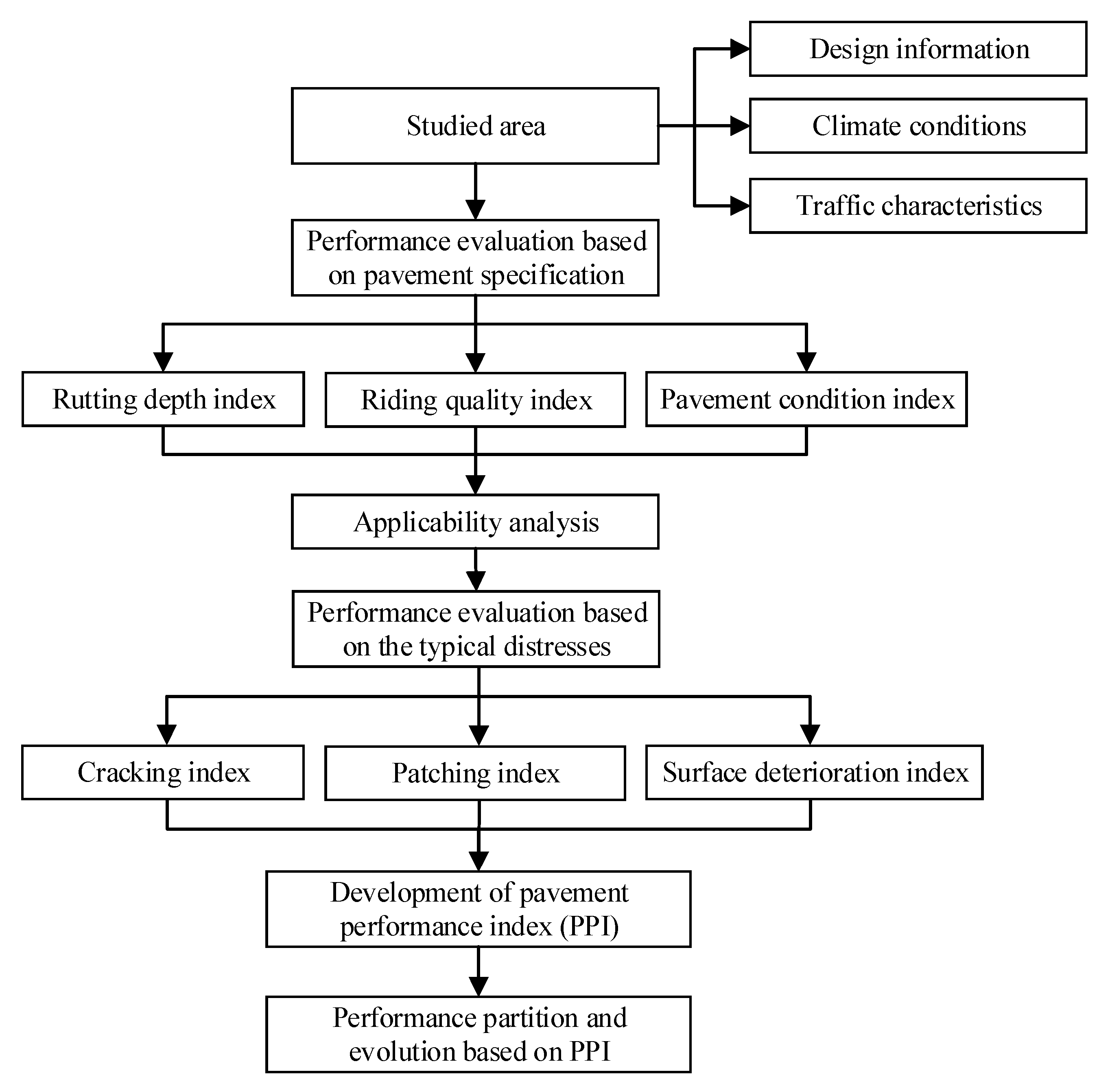


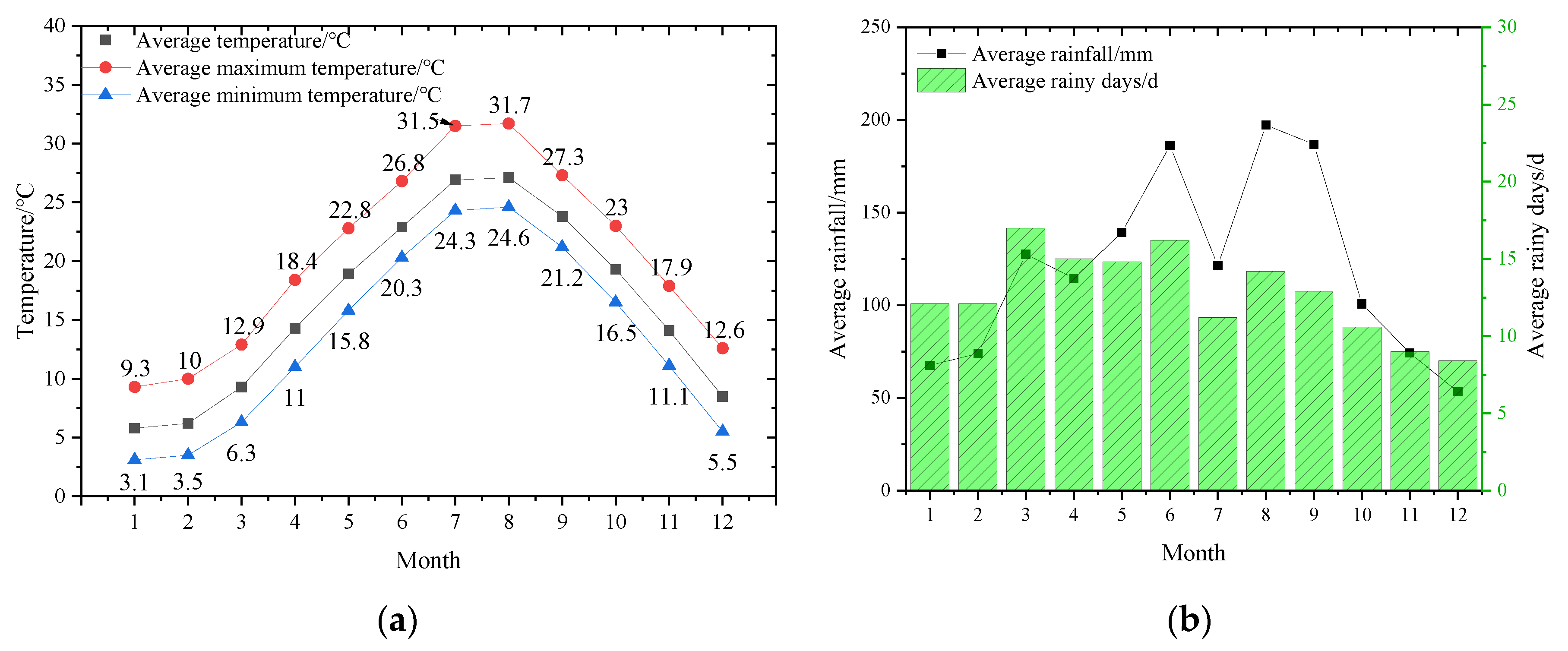
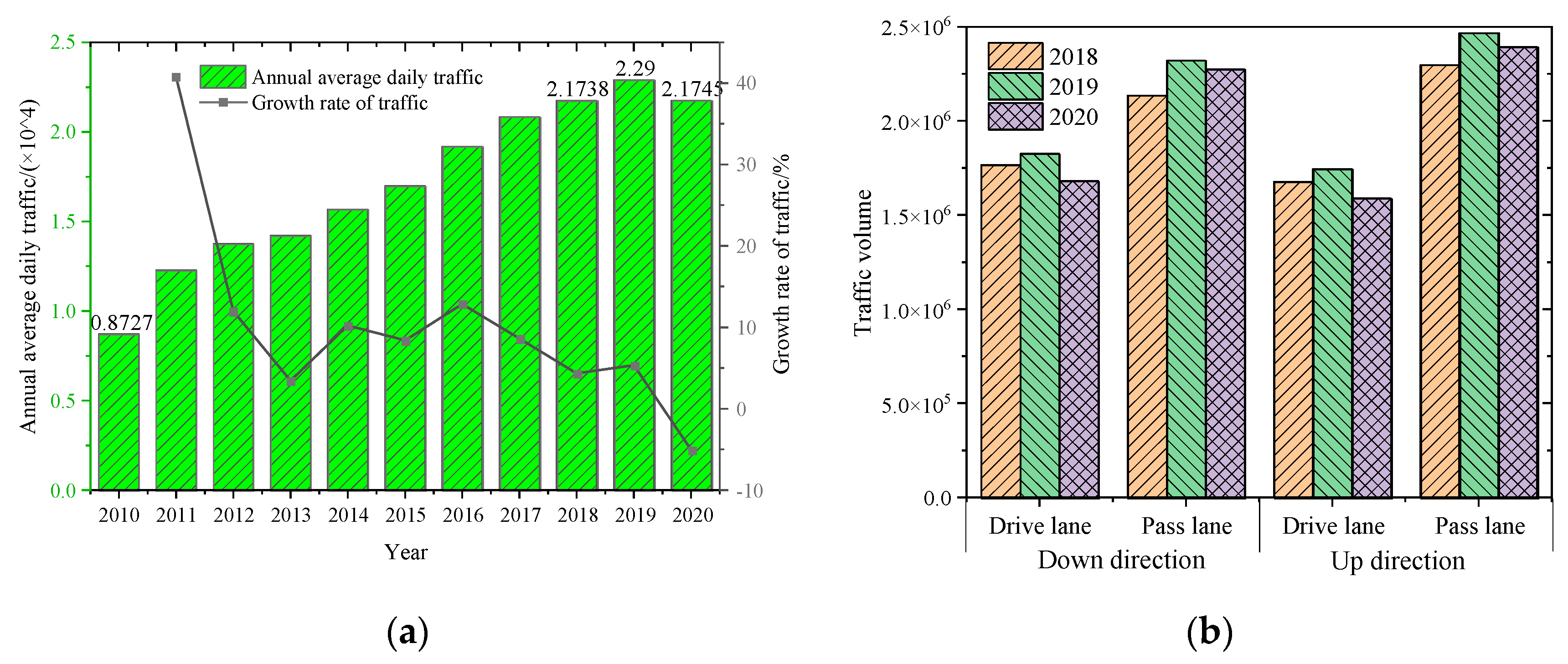
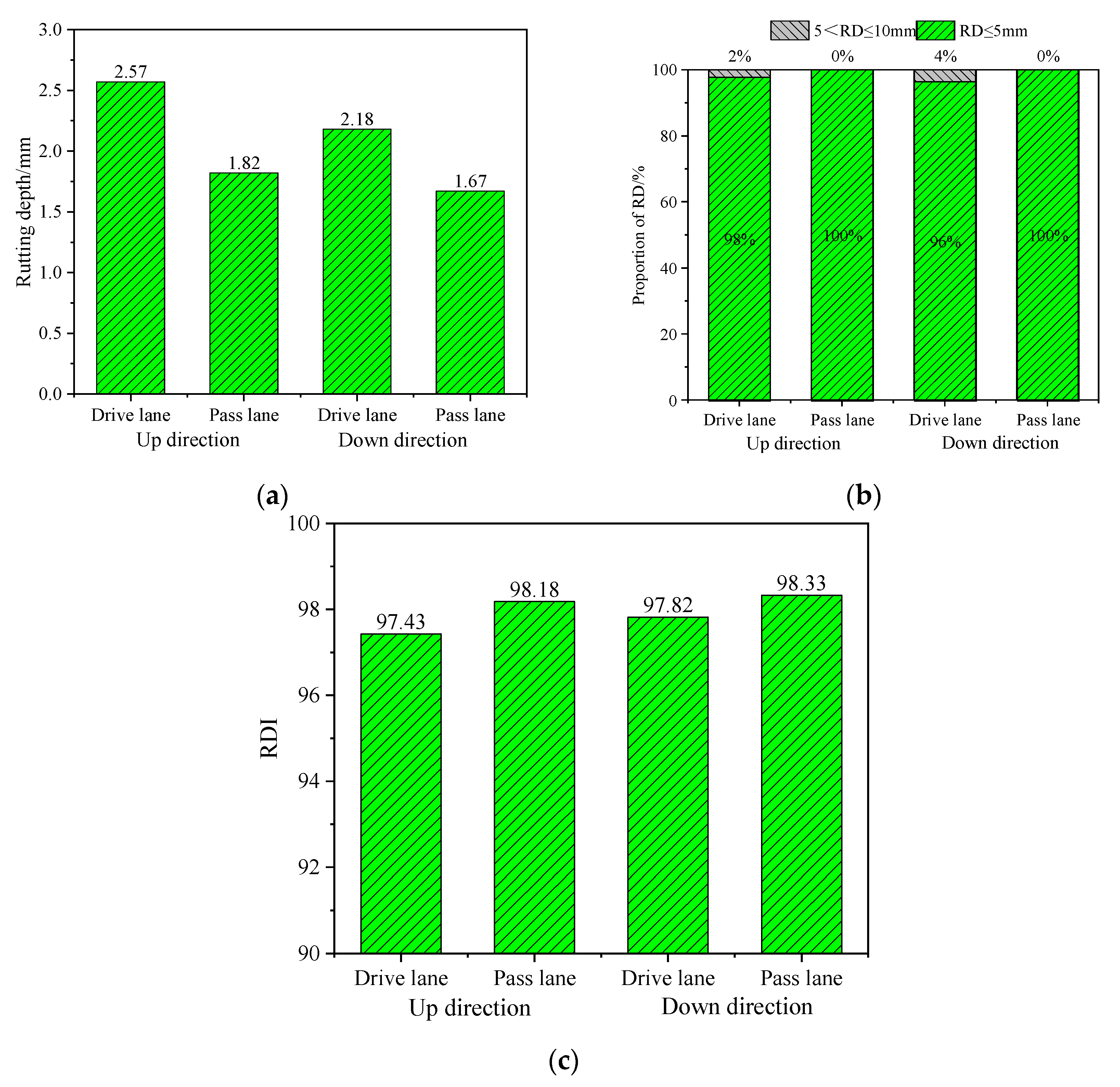
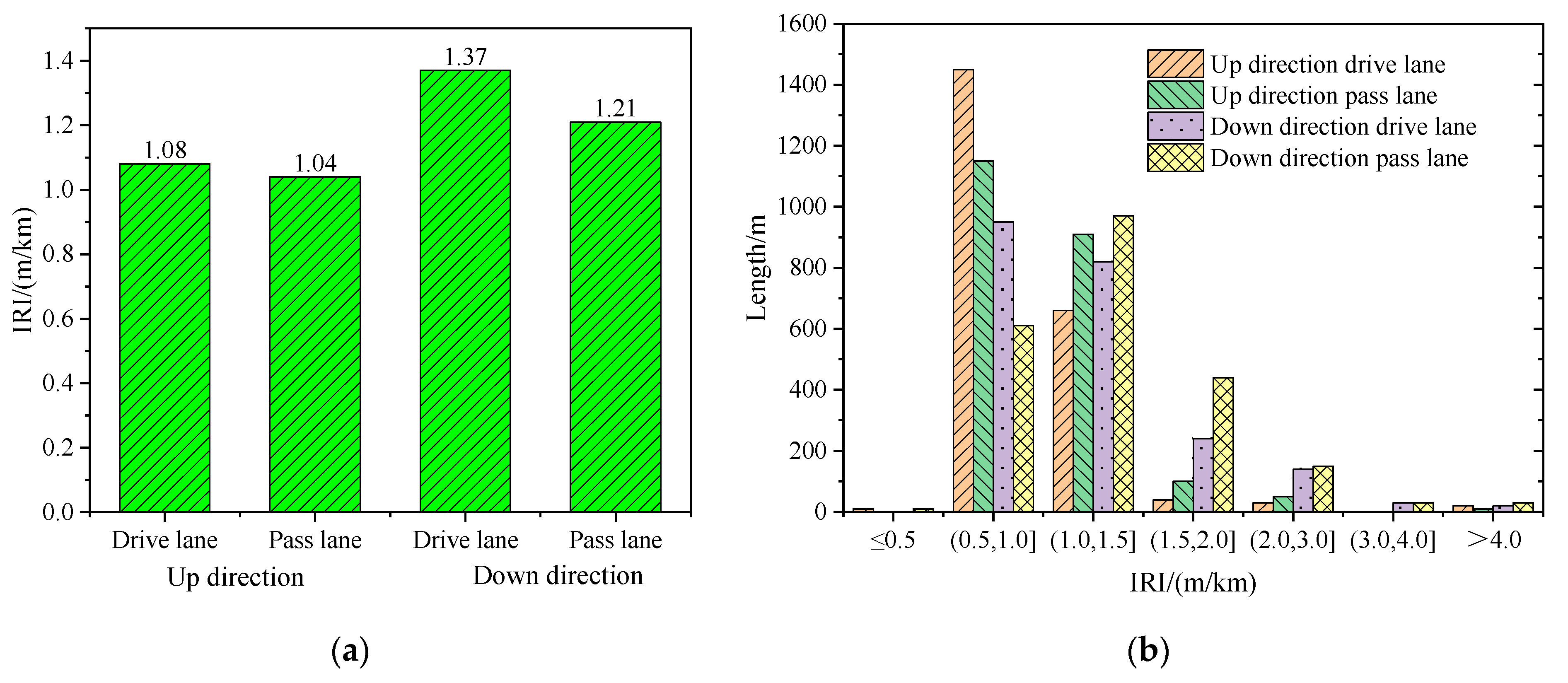
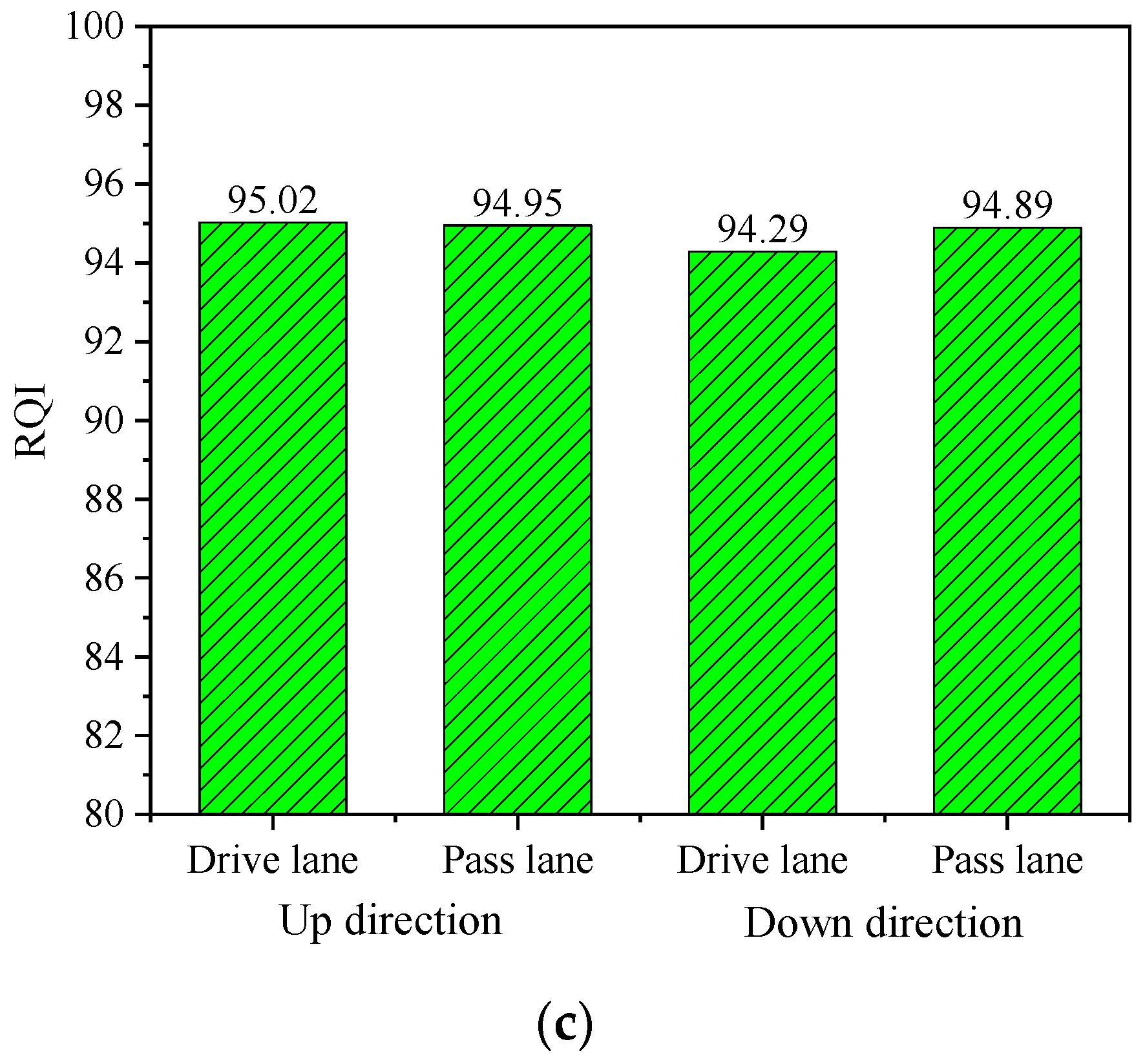


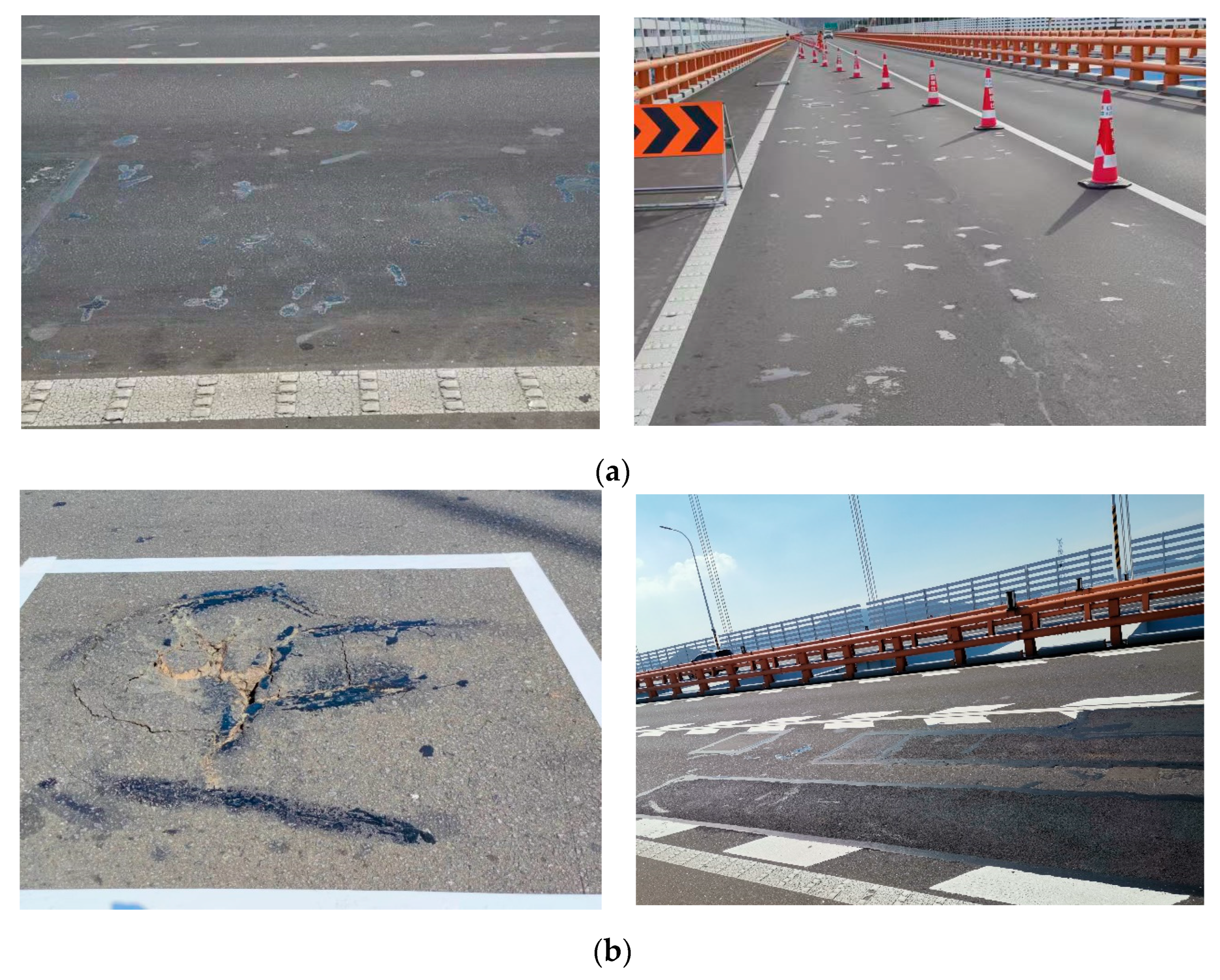
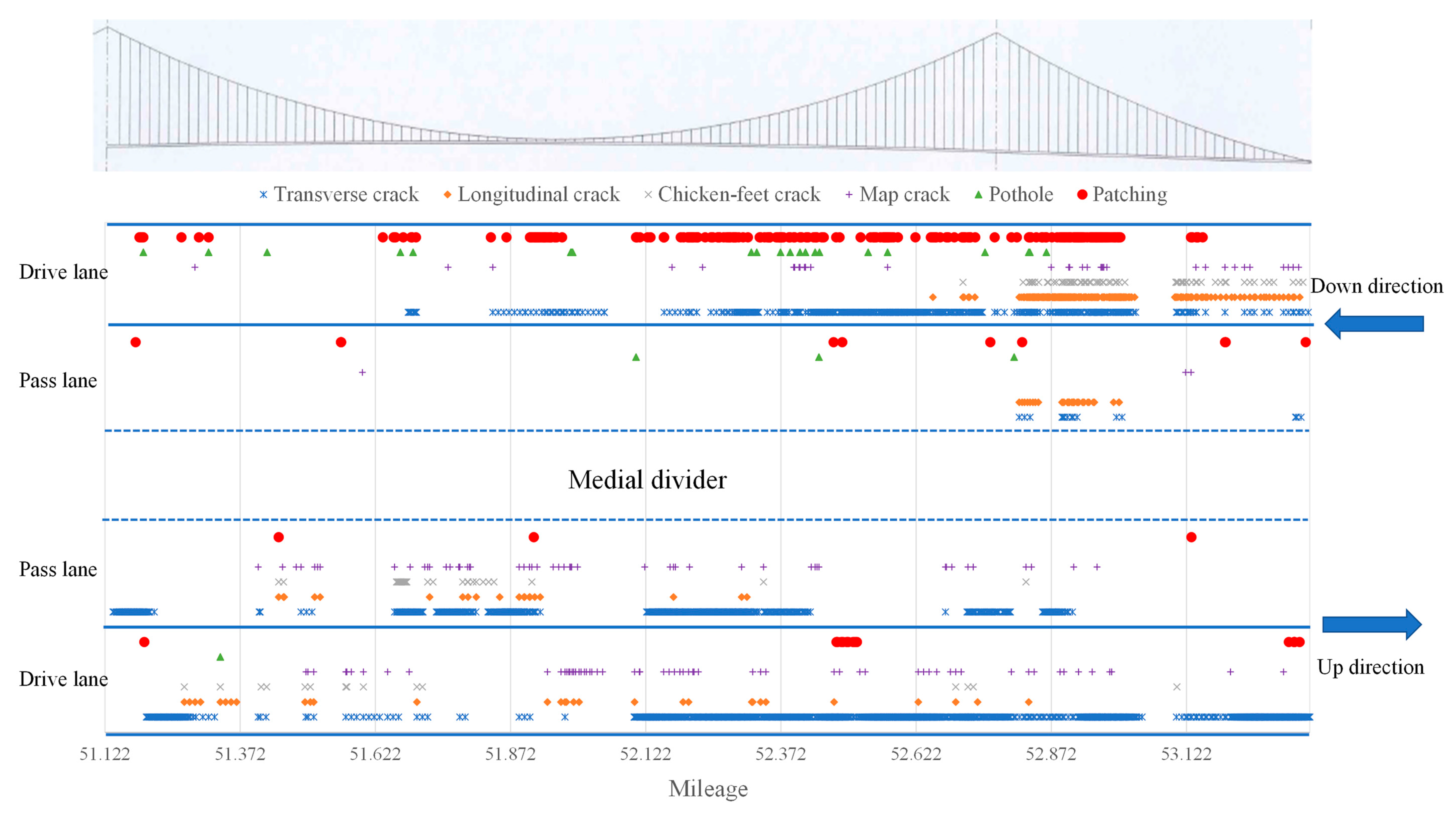
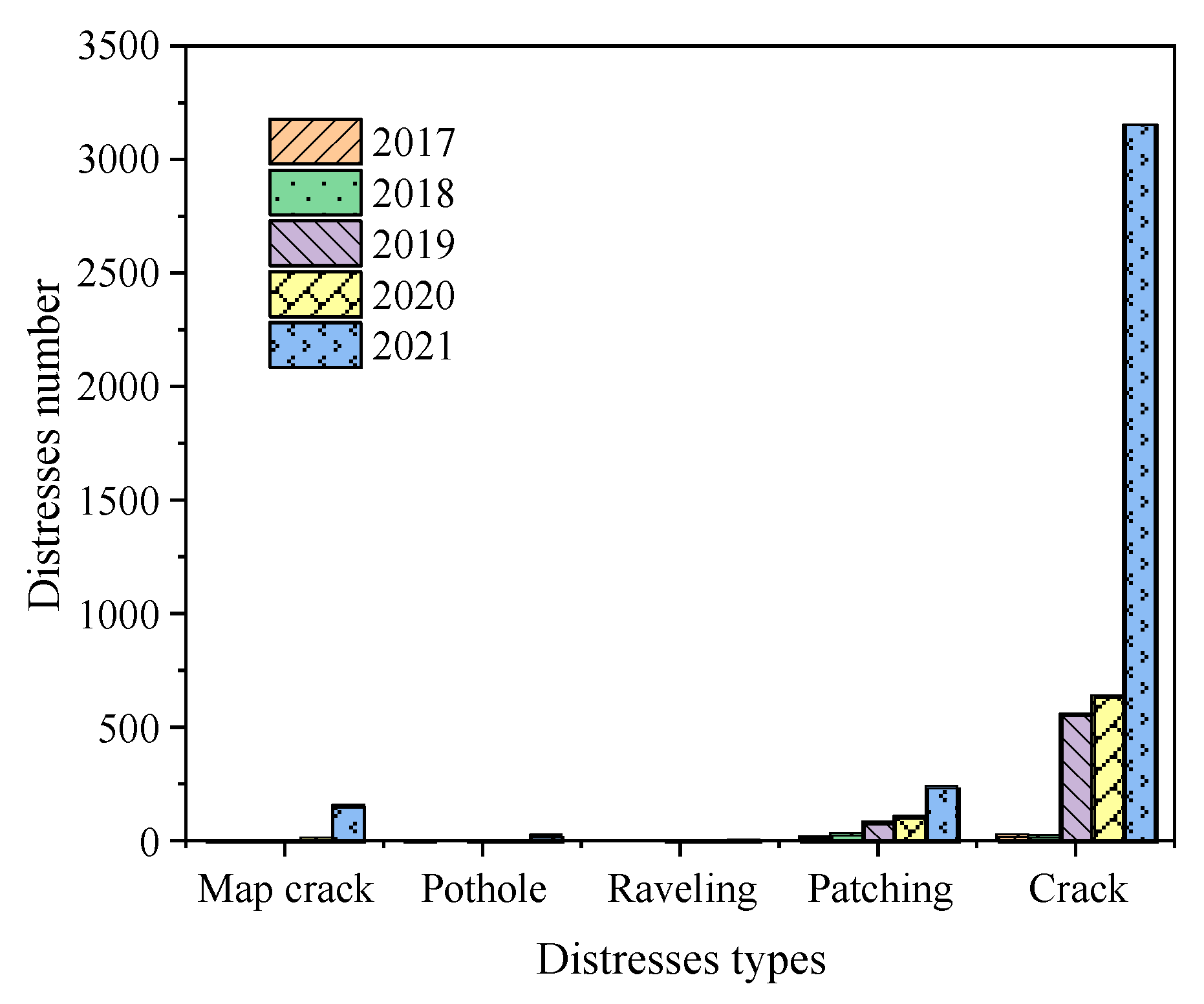
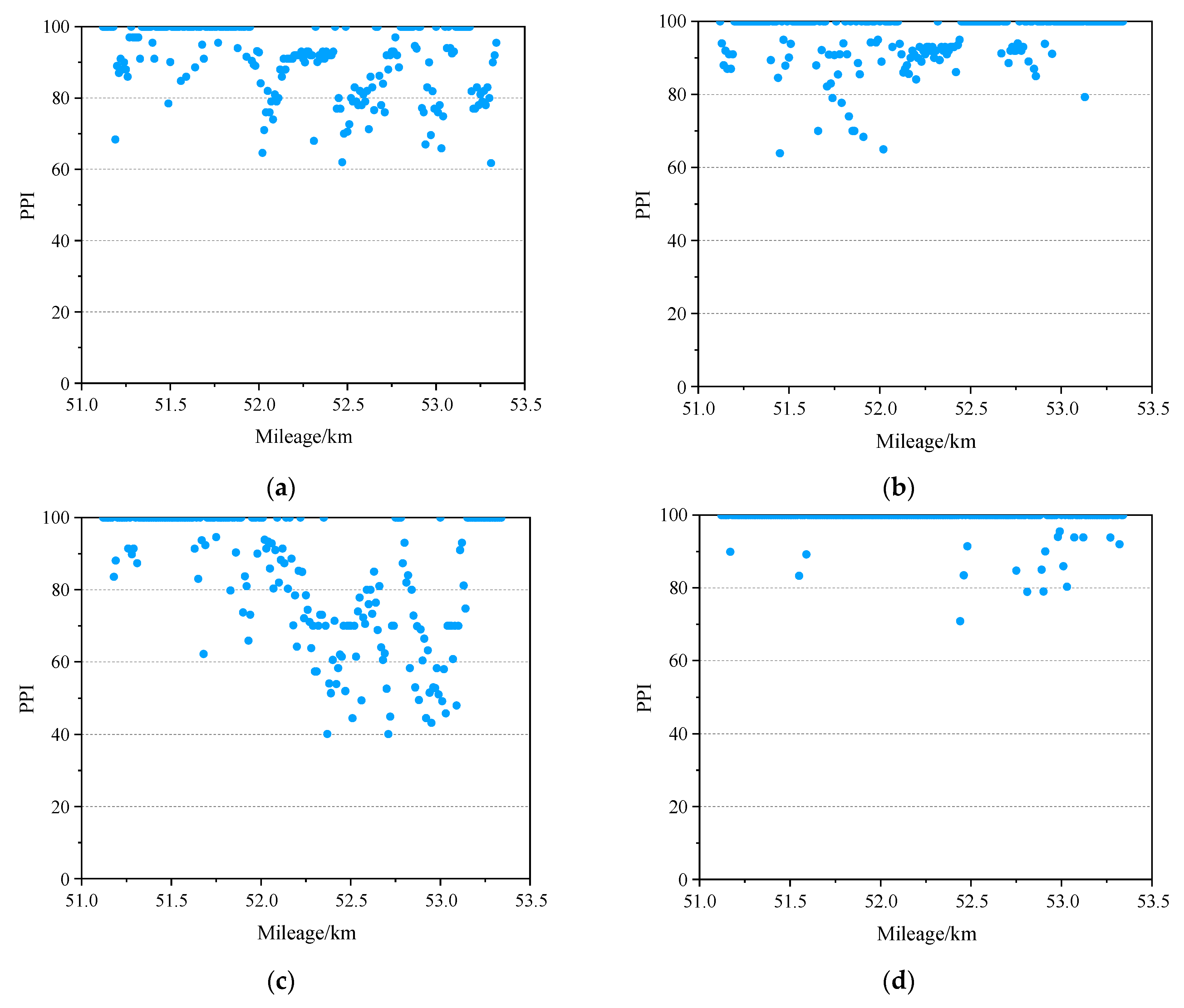
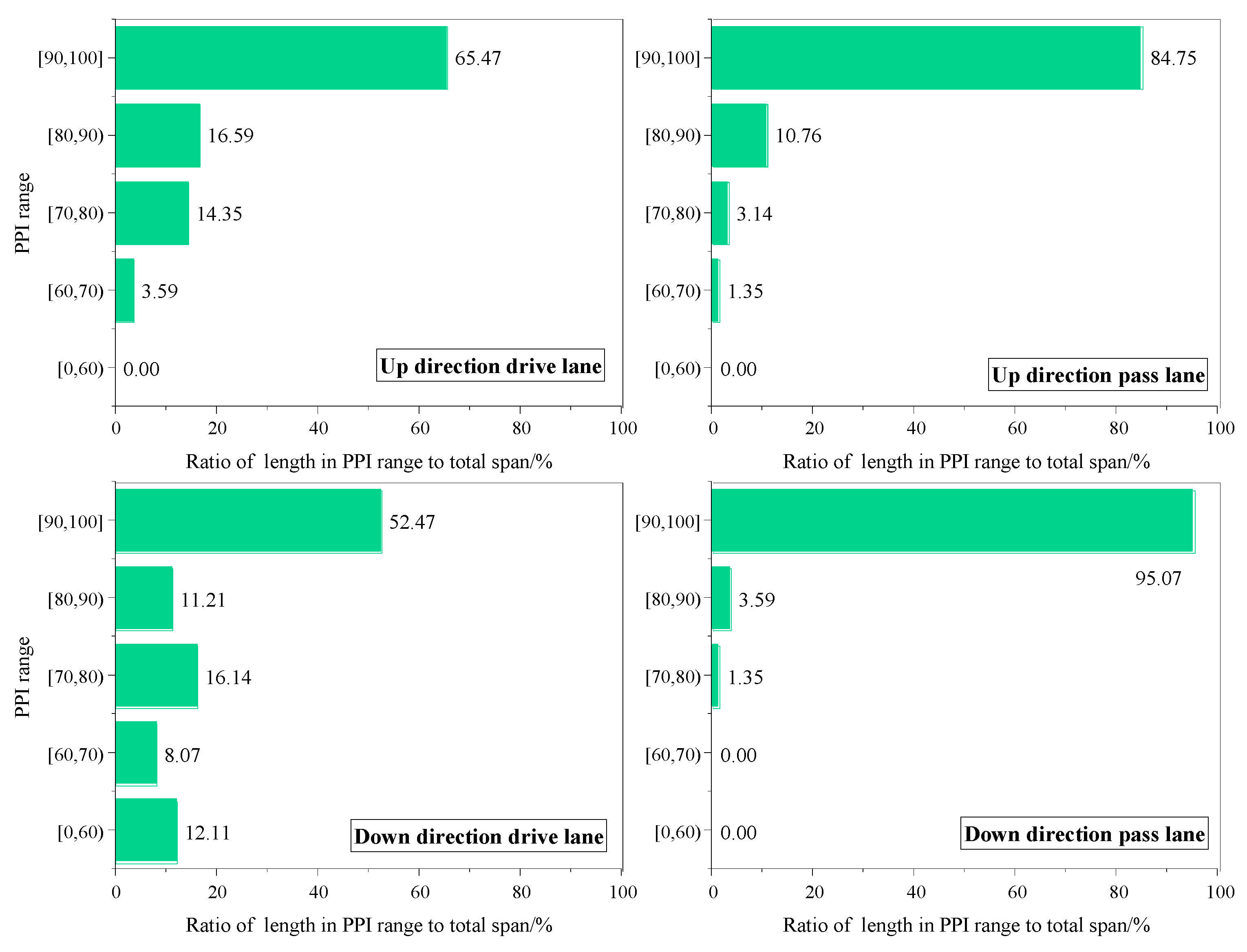
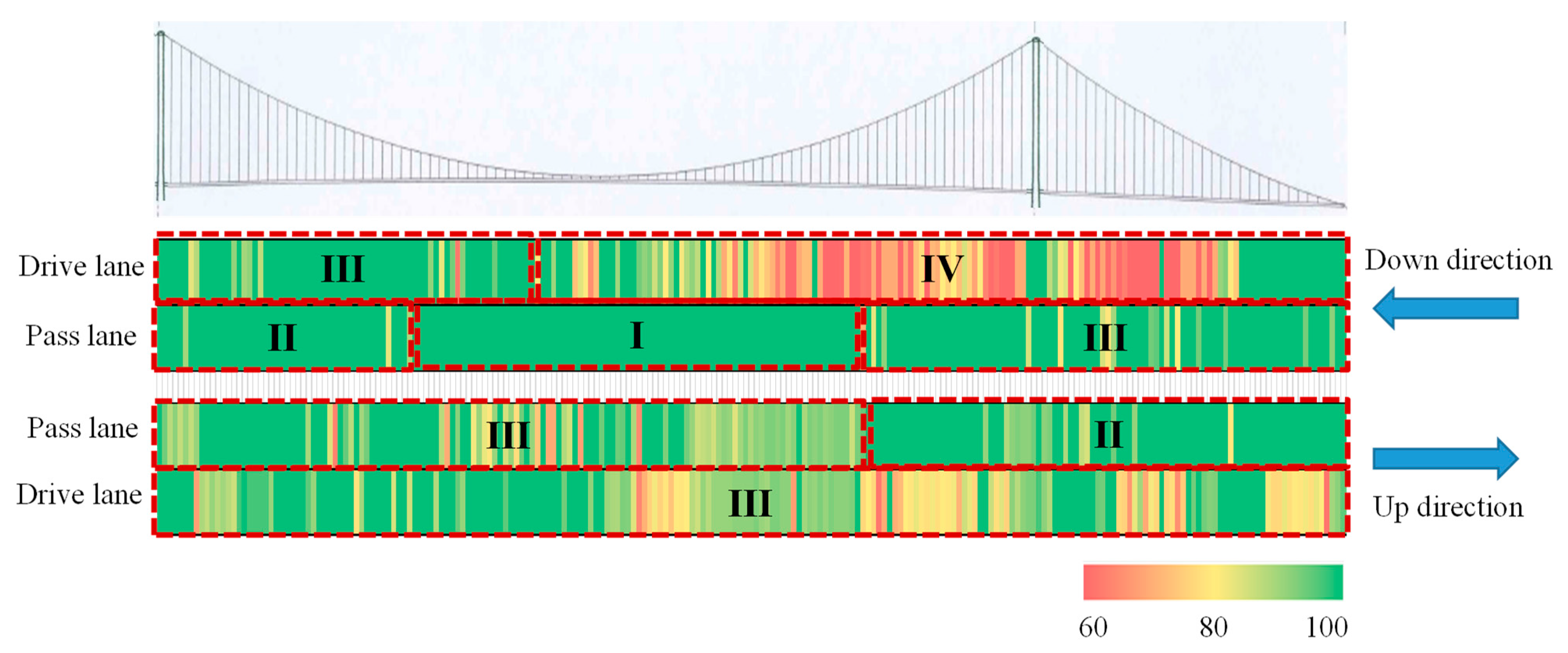
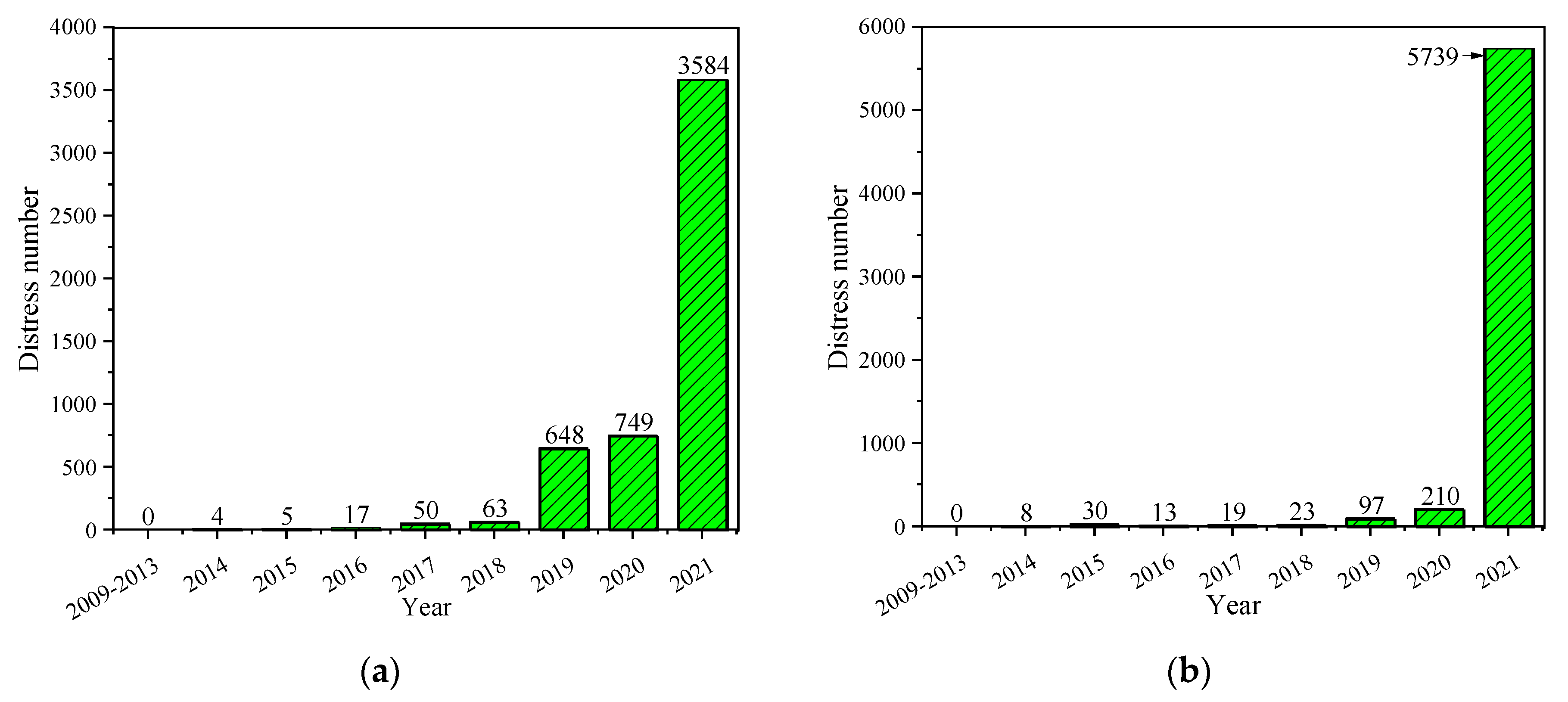
| Bridge Name | Xihoumen Bridge |
|---|---|
| Structure type | Suspension bridge |
| Opening time | December 2009 |
| Designed service life/year | 15 |
| Main span/m | 1650 |
| Total span/m | 2230 |
| Longitudinal gradient/% | 2.5 |
| Steel deck plate thickness/mm | 14 (Strengthening position: 16) |
| Stiffener thickness/mm | 8 |
| Distance between adjacent stiffeners/mm | 600 |
| Grade | A | B | C | D | E |
|---|---|---|---|---|---|
| RDI | [100, 90] | (90, 80] | (80, 70] | (70, 60] | (60, 0] |
| RD/mm | [0, 10] | (10, 13.3] | (13.3, 16.7] | (16.7, 20] | >20 |
| Grade | A | B | C | D | E |
|---|---|---|---|---|---|
| RQI | [100, 90] | (90, 80] | (80, 70] | (70, 60] | (60, 0] |
| IRI/mm | [0, 2.3] | (2.3, 3.5] | (3.5, 4.3] | (4.3, 5.0] | >5.0 |
| Total Length of Cracks/m | Number of Cracks | CI |
|---|---|---|
| [0, 0.1] | [0, 1] | [100, 90] |
| (0.1, 0.3] | (1, 3] | (90, 80] |
| (0.3, 2.7) | (3, 27) | (80, 0] |
| ≥2.7 | ≥27 | 0 |
| Total Patching Ratio/% | PI and SDI |
|---|---|
| [0, 0.05] | [100, 90] |
| (0.05, 0.2] | (90, 80] |
| (0.2, 0.5] | (80, 70] |
| (0.5, 1] | (70, 60] |
| (1, 2] | (60, 40] |
| (2, 8] | (40, 0] |
| >8 | 0 |
Disclaimer/Publisher’s Note: The statements, opinions and data contained in all publications are solely those of the individual author(s) and contributor(s) and not of MDPI and/or the editor(s). MDPI and/or the editor(s) disclaim responsibility for any injury to people or property resulting from any ideas, methods, instructions or products referred to in the content. |
© 2023 by the authors. Licensee MDPI, Basel, Switzerland. This article is an open access article distributed under the terms and conditions of the Creative Commons Attribution (CC BY) license (https://creativecommons.org/licenses/by/4.0/).
Share and Cite
Han, Y.; Zhang, Z.; Tian, J.; Ni, F.; Gu, X. Long-Term In Situ Performance Evaluation of Epoxy Asphalt Concrete for Long-Span Steel Bridge Deck Pavement. Coatings 2023, 13, 545. https://doi.org/10.3390/coatings13030545
Han Y, Zhang Z, Tian J, Ni F, Gu X. Long-Term In Situ Performance Evaluation of Epoxy Asphalt Concrete for Long-Span Steel Bridge Deck Pavement. Coatings. 2023; 13(3):545. https://doi.org/10.3390/coatings13030545
Chicago/Turabian StyleHan, Yajin, Zhu Zhang, Jiahao Tian, Fujian Ni, and Xingyu Gu. 2023. "Long-Term In Situ Performance Evaluation of Epoxy Asphalt Concrete for Long-Span Steel Bridge Deck Pavement" Coatings 13, no. 3: 545. https://doi.org/10.3390/coatings13030545
APA StyleHan, Y., Zhang, Z., Tian, J., Ni, F., & Gu, X. (2023). Long-Term In Situ Performance Evaluation of Epoxy Asphalt Concrete for Long-Span Steel Bridge Deck Pavement. Coatings, 13(3), 545. https://doi.org/10.3390/coatings13030545





